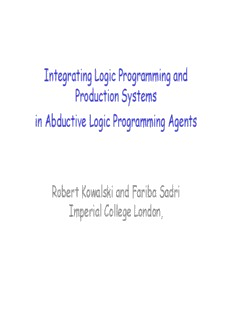
Integrating Logic Programming and Production Systems in Abductive Logic Programming Agents PDF
Preview Integrating Logic Programming and Production Systems in Abductive Logic Programming Agents
Integrating Logic Programming and Production Systems in Abductive Logic Programming Agents Robert Kowalski and Fariba Sadri Imperial College London, Outline of this talk • Confusions • Distinct functionalities • Abductive logic programming (ALP) • Evidence from Psychology Intelligent agents Deductive databases Abductive logic programming • ALP agents • The frame problem • LPS, a logic based production system language with a destructively changing database Confusions Russell and Norvig 2003 view production rules as just logical conditionals used to reason forward (page 286). Thagard, in Mind: Introduction to Cognitive Science 2005, argues that “Rules are if-then structures …very similar to the conditionals…, but they have different representational and computational properties.” (page 43). Simon, in the MIT Encyclopedia of Cognitive Science, includes Prolog “among the production systems widely used in cognitive simulation.” Rao, characterises AgentSpeak as “very similar to SLD-resolution of logic programming languages”, but ignores declarative semantics. Outline of this talk • Confusions • Distinct functionalities • Abductive logic programming (ALP) • Evidence from Psychology Intelligent agents Deductive databases Abductive logic programming • ALP agents • The frame problem • LPS, a logic based production system language with a destructively changing database Production Systems in Practice Three kinds of rules: reactive rules missing in logic programming forward chaining logic rules possible with logic programs goal-reduction rules typical of logic programming Production system cycle missing in logic programming Destructively changing database missing in logic programming Reactive rules implement stimulus-response associations Typically have implicit or emergent goals: if a car coming towards you then get out of its way has the implicit goal to stay safe. Forward chaining logic rules Give the impression that production rules are just conditionals used to reason forward: if X is human then X is mortal. Use forward chaining to implement forward reasoning. Goal-reduction rules Thagard claims that “Unlike logic, rule-based systems can also easily represent strategic information about what to do. Rules often contain actions that represent goals, such as IF you want to go home for the weekend and you have the bus fare, THEN you can catch a bus.” (page 45).” In logic programming, strategic rules are obtained by backward reasoning: you go home for the weekend if you have the bus fare and you catch a bus. The two most influential cognitive models, SOAR and ACT-R, mainly use production rules for goal-reduction. Five reasons for integrating production rules (PRs) and logic programs (LPs): 1. Eliminate the overlap between forward logic rules in PRs and forward/declarative clauses in LP. 2. Eliminate the overlap for goal-reduction. 3. Provide a better separation between goals and facts. 4. Provide a declarative semantics for PRs and for the combination of LP and PRs. 5. Provide a cycle and destructive database of facts, missing in LP. Other approaches In the majority of other approaches, production rules (PR) are mapped into LP. To our knowledge, there has been no work that combines both LP and PR side-by-side. Zaniolo and Statelog use a situation calculus-like representation with frame axioms, and reduce PRs and ECA rules to LPs. Both suffer from the frame problem.
Description: